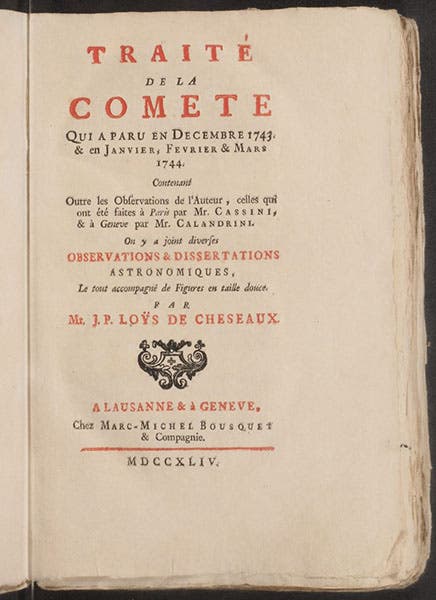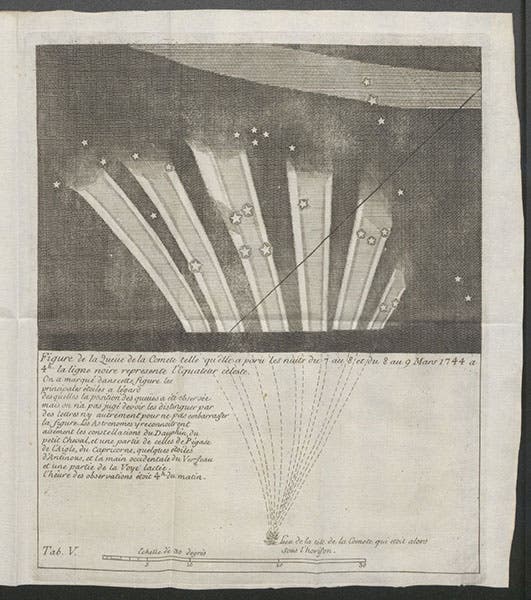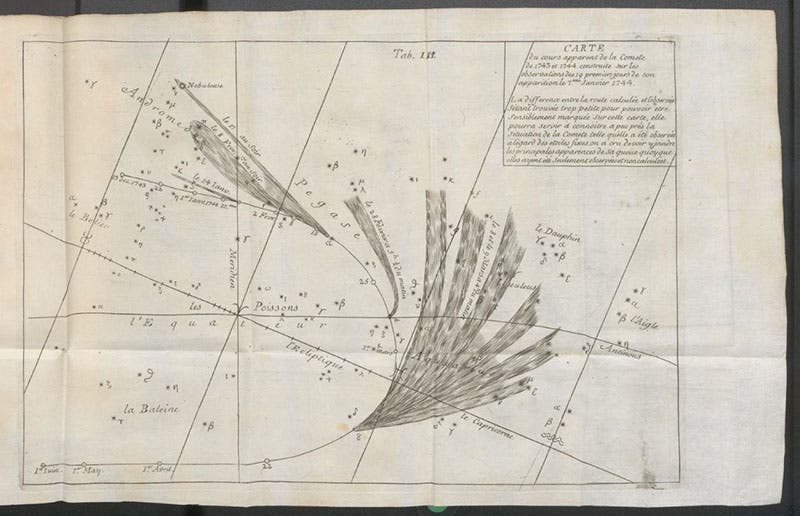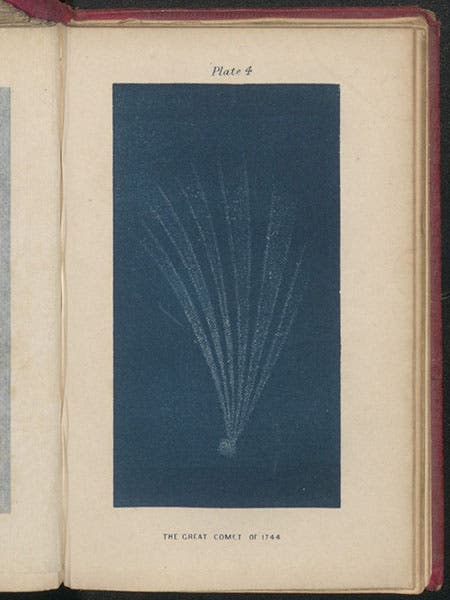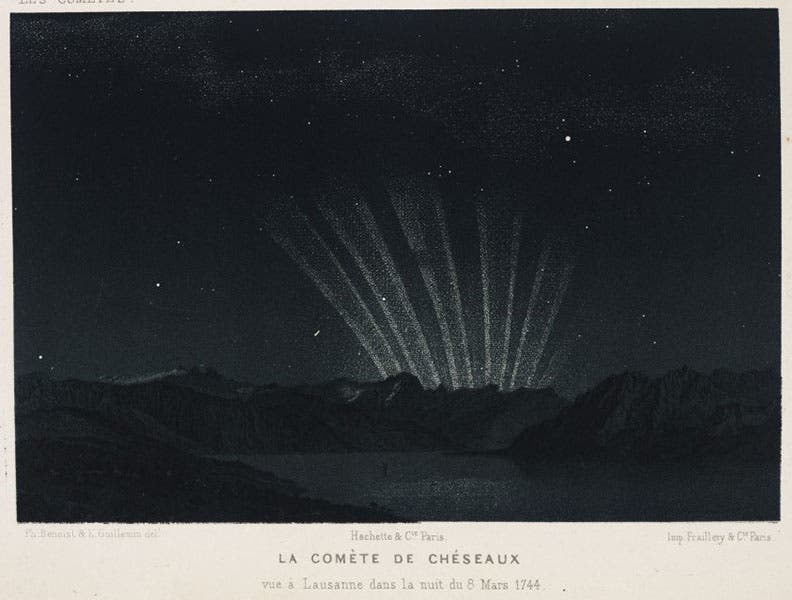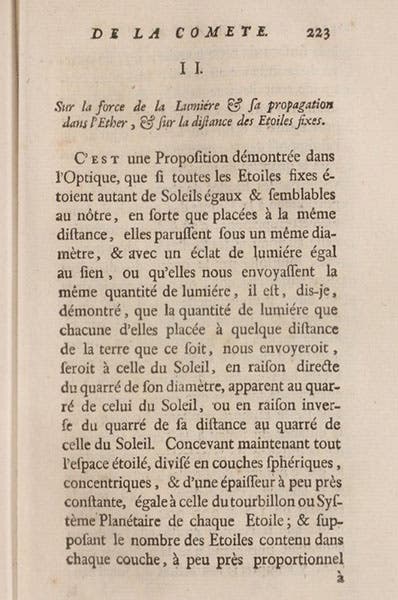Scientist of the Day - Jean-Philippe Loys de Cheseaux
Jean-Philippe Loys de Cheseaux, a Swiss astronomer from Lausanne, was born on May 4, 1718, which is not today's date. We celebrate him today because on Dec. 13, 1743, de Cheseaux spotted a comet in the sky. He was not the first to see the comet, having been preceded by a Dutch astronomer and a German. But the comet has been known ever since as Cheseaux's comet, because de Cheseaux observed it closely for the next three months, and when the comet passed near the sun (passed through perihelion) on Mar. 1, 1744 and soon thereafter sprouted six tails, he was there to sketch the unprecedented phenomenon. Better yet, within months, he brought to press a sizeable book on comets in general, and on the comet of 1743/44 in particular. The book includes an engraving of the six-tailed comet, as drawn on Mar. 8/9, 1744, as well as several diagrams of the path of the comet through the heavens, and its orbit through the solar system, both before and after it grew the six tails. We have this book in our History of Science collection, and we reproduce two of the engravings here. One shows the drawing of Mar. 8/9, and we show it twice: in detail, in our first image, and in its entirety, with half of the comet’s appearance extrapolated, since half of it was below the horizon at the time (fourth image, below).
The other engraving we reproduce is a map of the heavens, with the path of the comet superimposed (fifth image, below). The path begins at upper left, on Dec. 13, 1743, when de Cheseaux first saw the comet, culminates in the grand six-tailed appearance on Mar. 8/9, 1744, and then runs off the map on June 1 at bottom left.
Because the comet was so unusual, popular authors on the astronomy of the solar system for the next 150 years often reproduced de Cheseaux's engraving of Mar. 8. One of those was Denison Olmsted, whose Mechanism of the Heavens (1850) had a colored lithograph of Cheseaux's comet, which Olmsted called the Comet of 1744. We wrote a post on Olmsted just six months ago, and included several lithographs from his book, but not his version of Cheseaux's comet, so it is nice to be able to include it here (sixth image, below).
Amédée Guillemin wrote an entire book on comets in 1875, called Les Cometes, which was translated in 1877 as The World of Comets. We have both versions in our collections, and five years ago we wrote a post about the English edition, and we reproduced five of Guillemin's lithographs, including one that showed what he called "La comete de Cheseaux." So we show here a detail of that print (seventh image, above), so that you can better see the comet in the night sky. We have several other 19th- and early 20th-century books that depict Cheseaux's comet, but I trust the point is made. This was one of the most splendid comets ever seen, and as far as I know, de Cheseaux was the only one who recorded its image.
Among professional astronomers, de Cheseaux might be even better known for a short unillustrated section in the Traité de la comete, with the heading (here translated): “On the force of light, and its transmission through the ether, and on the distance of the fixed stars” (eighth image, above). Here de Cheseaux pointed out that if the stars extend out infinitely, then every possible line of sight must end in a star, and therefore the universe should be uniformly bright, even at night. Since the sky is not bright at night, this is a conundrum, which would later be called Olbers’ paradox, after Heinrich Olbers, the 19th-century German astronomer who supposedly first took note of it. Olbers was, however, preempted by de Cheseaux, who was in turn anticipated by Edmond Halley, who noted the same problem in 1720, as we mentioned in passing in our post on Halley last month.
There is only one true portrait of de Cheseaux, which was painted in 1746, when he was just 28 years old; it is somewhere on the campus of the University of Lausanne (second image). It is a good thing it was painted when it was, because five years later, de Cheseaux was dead, just 33 years old, having succumbed to an unknown ailment. It was a most unfortunate loss for the small community of European astronomers.
Dr. William B. Ashworth, Jr., Consultant for the History of Science, Linda Hall Library and Associate Professor emeritus, Department of History, University of Missouri-Kansas City. Comments or corrections are welcome; please direct to ashworthw@umkc.edu.



